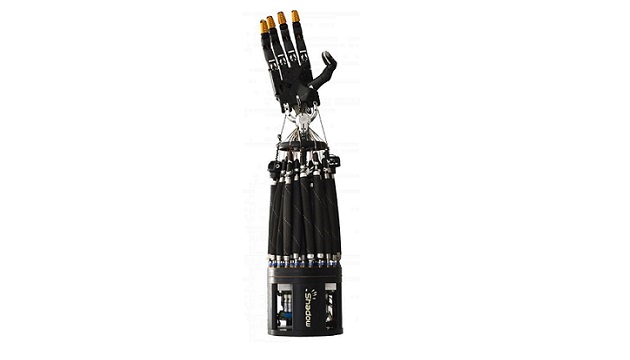Previously responsible for the rough, collaborative robots “Cobots” will take on more and more activities in the future – side by side with humans.
“For Luke of Papa” is written on the little yellow box. Shortly before, the Kuka lightweight robot put the white SIKU car with HARTING imprint there. Another Kuka robot drives it – past the trade fair visitor – to the next production cell, where the second vehicle is already waiting for Lukas. The order was placed by Papa in the specially designed web configurator the day before and triggered the order at the HANNOVER MESSE at the HARTING stand (Hall 11 / C15) via a QR code on his mobile phone.
HARTING’s Smart Factory “HAII4You” demonstrates the fully vertical integration from the customer to the flexible production of a product, divided into self-contained, yet fully networked production cells. The activities in each manufacturing cell are carried out by a collaborative Kuka lightweight robot. The goods are transported between the cells via a mobile Kuka iiwa robot.
In addition, PerFact Innovation, a partner company in MICA.network, has created digital twins of the system and robots. This generates a digital image of production processes, with the help of which remote maintenance and condition monitoring are visualized and simplified. The company Expleo reads the power moments of the robotic grippers to detect signs of wear. To do this, the data in the Microsoft Azure Cloud is evaluated and compared with historical data. The system at the HARTING stand thus demonstrates the entire range of modern production methods and connectivity in the sense of the trade fair theme Integrated Industry – Industrial Intelligence.
Swedish start-up builds the next-generation assembly workstation
A workplace for the intelligent, collaborative assembly of small parts is the business model of MTEK. The young company from Sweden is showing an assembly workstation with a collaborating robot at the HARTING stand. The two-armed ABB robot can detect and grasp small objects and is used for assembly and handicraft activities side by side with people.
MTEK’s business model is software as a service for process execution and control. “MICA and RFID make the assembly workstation and the process flow into an integrated unit with complete traceability,” says Olaf Wilmsmeier, Business Development Manager RFID at HARTING about cooperation with the Swedes. Wilmsmeier supported MTEK in the integration of HARTING’s UHF RFID technology and already knows the company from the NOKIA “Factory in a Box” joint project, which was one of the audience highlights at HANNOVER MESSE 2018.
Replica of human gripping
Meanwhile, researchers are working to further develop the gripping processes of robotic arms and grippers and to enrich a haptic perception. How advanced technologies are in this area is demonstrated by HARTING in cooperation with Shadow Robot Company Ltd. The British company has designed a robotic hand in the function and dimension of a human hand to develop algorithms for the simulation of human gripping. The hand has 24 joints, 20 of which can be controlled independently. The ability to rotate in all directions gives a precise and reliable grip on the objects.
Multi-functional sensors have been integrated into the fingertips to measure different functions such as pressure sensitivity, temperature and vibration. The fingertips of the robot hand are produced at HARTING AG Biel in Switzerland by means of the 3D-MID technology (Mechatronic Integrated Device – injection-molded circuit carrier). This makes it possible to equip sensor functions directly on a three-dimensional base body.
Simulation of human gripping processes
Researchers have been working on further developments for the gripping processes of
robot arms and grippers and enriching them with haptic perception. In cooperation with
Shadow Robot Company Ltd, HARTING demonstrates just how advanced technologies
are in this field. This British company has constructed a robot hand with the functionality
and dimensions of a human hand so that it can develop algorithms for simulating human
gripping processes. The hand has 24 joints, 20 of which can be controlled independently
from each other. Its ability to rotate in all directions enables it to get a precise and reliable
grip on objects.
Multi-functional sensors have been built into the fingertips to measure various functions
such as pressure sensitivity, temperature and vibration. The fingertips of the robot hand
have been created at HARTING AG Biel in Switzerland using 3D-MID (Mechatronic
Integrated Device) technology. This makes it possible to equip sensor functionality directly
into a three-dimensional base body.
Courtesy: www.harting.com








